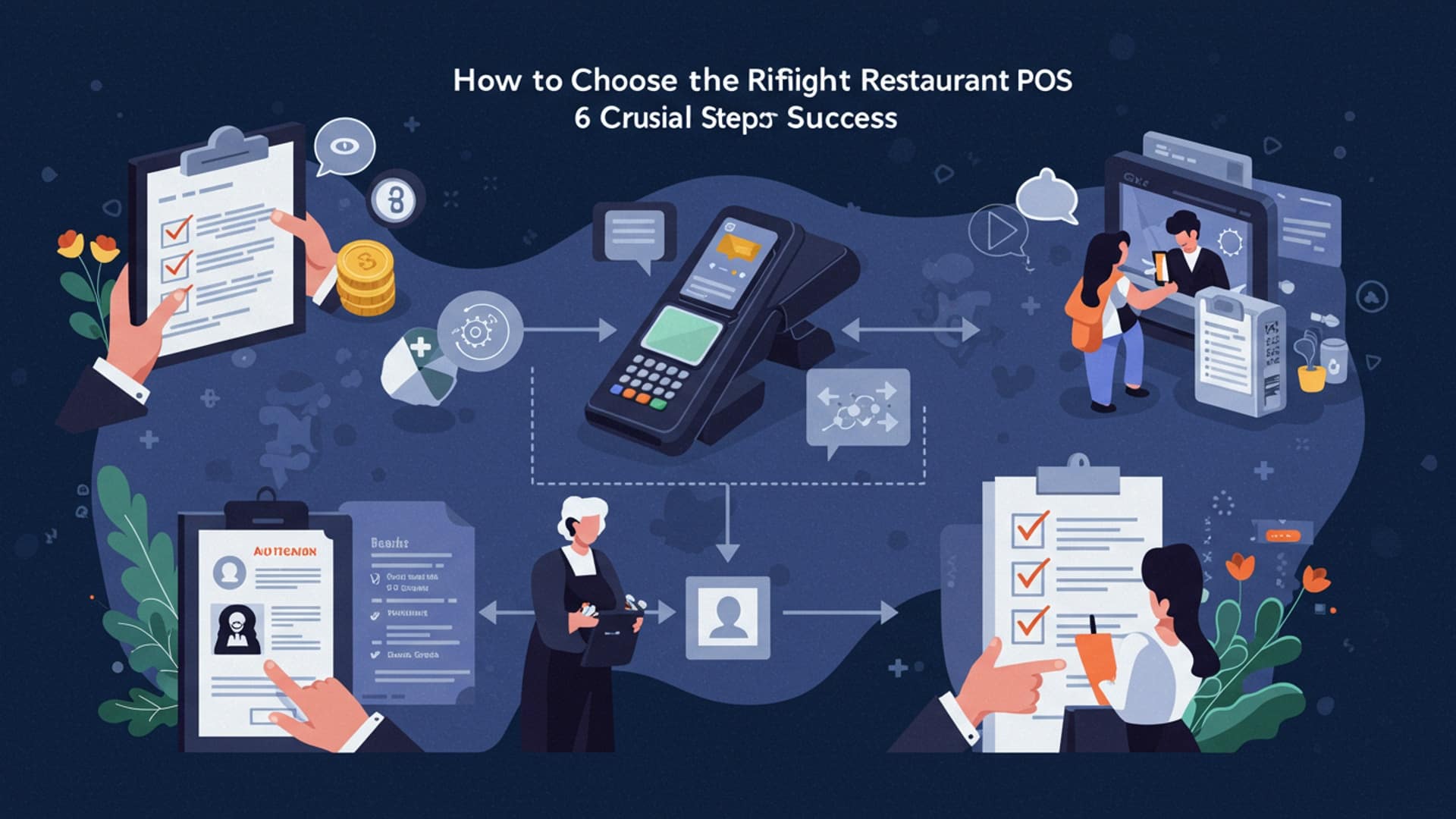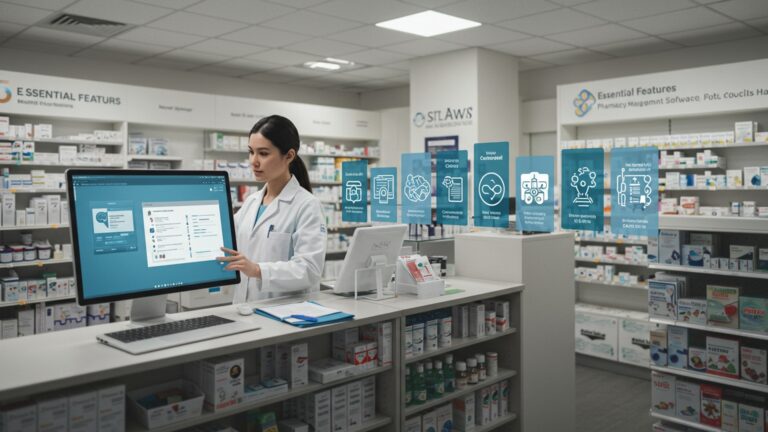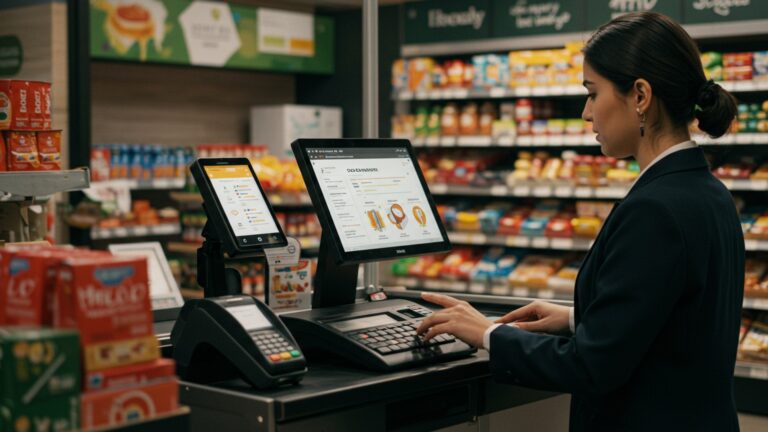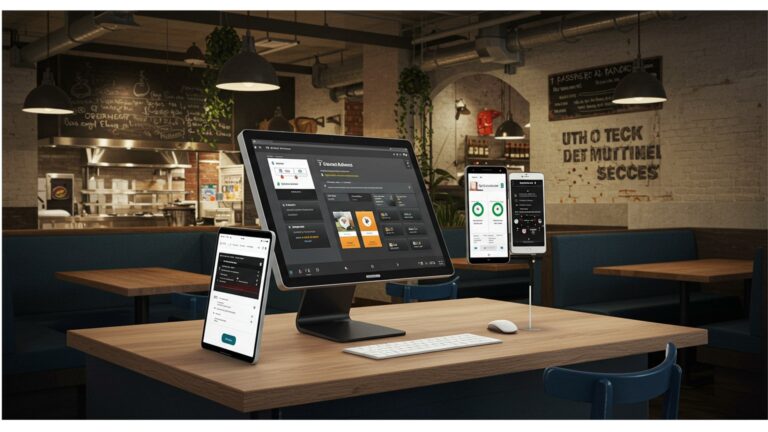How to Choose the Right Restaurant POS 6 Crucial Steps for Success
The modern restaurant operates at a breakneck pace, demanding far more than a basic transaction system; it requires sophisticated restaurant POS software to serve as the central nervous system for everything from dynamic menu updates and inventory control to seamless third-party delivery integrations. In an industry increasingly reliant on contactless payments, QR code ordering. hyper-personalized guest experiences, selecting the wrong system can easily bottleneck operations, leading to lost revenue and diminished customer satisfaction. Astute restaurateurs recognize that a truly effective POS transcends simple order processing, providing crucial real-time data analytics for optimized staffing, supply chain management. ultimately, a superior guest journey.

Understanding Your Restaurant’s Unique Needs and What Restaurant POS Software Entails
Before diving into the myriad of options available, the very first and most critical step is to deeply grasp your restaurant’s unique operational needs. No two restaurants are exactly alike. what works perfectly for a quick-service cafe might be a complete mismatch for a fine-dining establishment. A Restaurant POS software, or Point of Sale system, is the central nervous system of your operation, handling everything from taking orders and processing payments to managing inventory and generating sales reports. It’s far more than just a cash register; it’s a comprehensive management tool.
To identify your specific requirements, consider the following:
- Restaurant Type
- Quick-Service Restaurants (QSRs) / Cafes
- Fine Dining
- Bars / Pubs
- Food Trucks / Pop-ups
- Operational Flow
- Current Challenges
- Future Goals
Prioritize speed, efficient order entry, self-service options (kiosks). quick payment processing. Your POS needs to handle high transaction volumes rapidly.
Focus on table management, reservation systems, custom order modifications, split checks. detailed customer profiles for personalized service.
Look for robust tab management, happy hour pricing capabilities, age verification integration. quick reordering features.
Mobility is key. A cloud-based, mobile-friendly Restaurant POS software with offline capabilities and wireless payment processing is essential.
Map out how orders are taken, sent to the kitchen, prepared. served. Does your staff use handheld devices? Do customers order via QR codes? How are tips managed?
What are your biggest pain points with your current system or manual processes? Is it slow order taking, inaccurate inventory, or difficulty tracking sales performance? Your new Restaurant POS software should directly address these issues.
Are you planning to expand, offer online ordering, or implement a loyalty program? Your chosen system should be able to support these ambitions.
For example, a busy pizza shop owner recently shared how their old, clunky system led to frequent order errors and slow service during peak hours. By switching to a modern Restaurant POS software with intuitive touch-screen ordering and direct kitchen display system (KDS) integration, they significantly reduced errors and sped up service, directly impacting customer satisfaction and bottom-line revenue. This initial self-assessment is paramount to narrowing down suitable options.
Identifying Core Features: What Your Restaurant POS Software Must Have
Once you grasp your needs, the next step is to evaluate the core features offered by various Restaurant POS software solutions. While some features are universal, others are specific to certain restaurant types or operational models. Here are the non-negotiables:
- Order Management
- Intuitive Order Entry
- Customizable Menus
- Table Management
- Split & Merge Checks
- Kitchen Display System (KDS) Integration
- Payment Processing
- Integrated Payments
- EMV Compliance
- Tip Management
- Offline Mode
- Inventory Management
- Ingredient Tracking
- Recipe Management
- Supplier Management
- Waste Tracking
- Reporting and Analytics
- Sales Reports
- Labor Reports
- Cost of Goods Sold (COGS)
- Customer Data
- Employee Management
- Time Clock
- Permissions
- Performance Tracking
Easy-to-use interface for quick and accurate order taking.
Ability to add modifiers, special instructions. daily specials.
Visual floor plans, table status tracking. easy table transfers.
Flexibility to split bills by item or evenly. merge tables.
Sends orders directly to the kitchen, reducing paper waste and improving communication.
Seamlessly handles credit/debit cards, mobile payments (Apple Pay, Google Pay). gift cards.
Securely processes chip card transactions.
Easy tip adjustments and reporting for staff payouts.
Ability to process payments even if internet connectivity is lost temporarily.
Monitors stock levels of raw ingredients and finished dishes.
Helps control portion sizes and costs.
Tracks supplier insights and purchase orders.
Identifies areas of loss to improve efficiency.
Detailed insights into sales performance by item, time, server, etc.
Tracks employee hours, tips. payroll data.
Helps grasp profitability.
Gathers insights into customer preferences and spending habits.
Tracks employee clock-ins and outs.
Assigns different access levels for staff roles.
Monitors individual server sales and efficiency.
Consider a scenario where a restaurant owner discovered they were consistently running out of a popular ingredient for their signature dish. Their new Restaurant POS software, with its robust inventory tracking, not only alerted them when stock was low but also provided historical usage data, allowing them to optimize ordering and prevent future shortages. This direct impact on operations highlights the value of comprehensive features.
Scalability and Future-Proofing Your Investment
Choosing a Restaurant POS software isn’t just about meeting today’s needs; it’s about preparing for tomorrow. Your business will hopefully grow. your technology should be able to grow with it. This is where scalability becomes crucial. A system that can easily adapt to increased transaction volumes, additional locations, or new service models (like online ordering or catering) will save you significant headaches and costs down the line.
A key consideration for scalability is whether the Restaurant POS software is cloud-based or on-premise:
| Feature | Cloud-Based Restaurant POS Software | On-Premise Restaurant POS Software |
|---|---|---|
| Data Storage | Data stored securely on remote servers, accessible via internet. | Data stored locally on your restaurant’s hardware. |
| Accessibility | Access from anywhere, on any device with an internet connection. Ideal for multi-location management. | Access usually limited to the restaurant’s local network. |
| Upgrades & Maintenance | Automatically updated by the provider; minimal IT involvement. | Requires manual updates and maintenance by your staff or IT provider. |
| Initial Cost | Typically lower upfront cost, subscription-based. | Higher upfront cost for hardware and software licenses. |
| Operational Cost | Predictable monthly/annual subscription fees. | Ongoing maintenance, support. potential upgrade costs. |
| Scalability | Highly scalable; easily add terminals, locations. features. | More complex and costly to scale, often requires significant hardware upgrades. |
| Security | Managed by provider with professional-grade security measures and backups. | Relies on your internal IT security and backup protocols. |
Most modern restaurants opt for cloud-based Restaurant POS software due to its flexibility, lower upfront investment. ease of scalability. For instance, a small cafe that plans to open a second location within a year would find a cloud-based system invaluable. They can simply add new terminals and locations to their existing account, accessing all data and reports from a single dashboard, rather than installing entirely new, separate systems.
Seamless Integration Capabilities: Connecting Your Ecosystem
In today’s interconnected business world, your Restaurant POS software shouldn’t operate in a silo. Its ability to integrate with other essential business tools can dramatically streamline operations, eliminate manual data entry. provide a more holistic view of your business. When evaluating a POS, inquire about its integration ecosystem.
Key integrations to consider include:
- Online Ordering Platforms
- Accounting Software
- Loyalty Programs & CRM
- Employee Scheduling & Payroll
- Third-Party Delivery Management
Direct integration with services like DoorDash, Uber Eats, Grubhub, or your own native online ordering system means orders flow directly into your POS, reducing manual entry errors and speeding up order processing.
Seamlessly sync sales data, expenses. payroll insights with platforms like QuickBooks, Xero, or Sage. This saves countless hours on bookkeeping and ensures financial accuracy.
Integrate with customer relationship management (CRM) tools and loyalty programs to track customer preferences, reward loyal patrons. run targeted marketing campaigns.
Connect with tools like When I Work or Homebase to manage staff schedules, track hours. simplify payroll processing.
For restaurants heavily relying on delivery, integrations with delivery management platforms can optimize driver dispatch and logistics.
Imagine a restaurant owner who used to manually input online orders from three different platforms into their POS, then transfer sales data to their accounting software at the end of each week. This was a tedious, error-prone process. By choosing a Restaurant POS software that integrated with all these systems, they eliminated manual data entry, freed up staff time. gained real-time financial insights, allowing them to make quicker, more informed business decisions.
User Experience (UX), Training. Customer Support
Even the most feature-rich Restaurant POS software is useless if your staff can’t figure out how to use it. A positive user experience (UX) is paramount. The interface should be intuitive, easy to navigate. require minimal training for new employees. Think about the fast-paced, high-pressure environment of a restaurant – staff need to execute tasks quickly and accurately without fumbling through complex menus.
- Intuitive Interface
- Ease of Training
- Reliable Customer Support
- Availability
- Channels
- Responsiveness
- Onboarding & Documentation
Look for clean designs, logical workflows. customizable layouts that mirror your menu structure. Test it out during a demo – can a new server take an order efficiently?
How long does it take to train new staff? A system that’s easy to learn reduces training costs and gets new hires productive faster.
Does the provider offer 24/7 support? Restaurants operate beyond typical business hours, so support needs to be available when you need it most.
Can you reach them via phone, email, live chat, or an online knowledge base?
What’s their typical response time? A downed POS system can halt your entire operation.
Does the provider offer comprehensive onboarding assistance, training materials. clear documentation?
A personal anecdote highlights this: A bustling downtown diner invested in a cutting-edge Restaurant POS software but faced immediate backlash from their long-time staff. The system, while powerful, had a steep learning curve and lacked adequate training resources. The resulting frustration led to slower service, order mistakes. decreased morale. Eventually, they switched to a system known for its user-friendliness and comprehensive training modules, which instantly improved staff adoption and operational efficiency.
Evaluating Cost and Calculating Your Return on Investment (ROI)
The final. by no means least crucial, step is to carefully evaluate the total cost of ownership and project your potential return on investment (ROI). The sticker price of a Restaurant POS software can be misleading; you need to consider all associated costs.
- Hardware Costs
- Software Costs
- Subscription Fees
- License Fees
- Payment Processing Fees
- Installation and Setup Fees
- Training Fees
- Ongoing Support and Maintenance
This includes POS terminals (touchscreens), receipt printers, cash drawers, kitchen display screens, handheld devices. payment terminals. Some providers offer bundled packages.
Most cloud-based systems operate on a monthly or annual subscription model, often tiered by the number of terminals or features.
On-premise systems typically involve an upfront software license fee.
interpret the transaction fees associated with credit card processing. These can vary significantly between providers and can impact your bottom line.
Some providers charge for initial setup, data migration. on-site installation.
While some basic training is often included, extensive or custom training might incur additional costs.
Factor in any recurring support contracts or fees for updates (especially for on-premise systems).
To calculate ROI, consider how the new Restaurant POS software will save you money or increase revenue:
- Reduced Labor Costs
- Decreased Waste
- Increased Sales
- Reduced Errors
- Improved Reporting
Faster order taking, automated inventory. simplified payroll can reduce staff hours or free them up for more impactful tasks.
Better inventory management and recipe costing can minimize food waste.
Efficient service, integrated online ordering. loyalty programs can lead to higher customer satisfaction and repeat business.
Automated processes minimize human error, saving costs on remade orders or incorrect billing.
Better data allows for more informed decisions on menu pricing, staffing levels. promotions, directly boosting profitability.
For example, a restaurant that previously used manual inventory tracking estimated they lost 5% of their food costs due to spoilage and unaccounted items. By implementing a Restaurant POS software with robust inventory features, they reduced this loss by half, saving thousands of dollars annually. This tangible saving, combined with efficiencies in labor and reporting, quickly justified the initial investment, demonstrating a clear and compelling ROI.
Conclusion
Choosing your restaurant POS isn’t merely a transaction; it’s a strategic investment in your establishment’s future. As we’ve explored the six crucial steps, remember that the right system, like a well-oiled kitchen, seamlessly supports every operation, from the rush of dinner service to detailed inventory management. My personal tip? Always prioritize a system that offers robust, real-time data analytics—it’s not just about processing orders anymore; it’s about understanding your business’s pulse, especially with the current trend of personalized customer experiences and dynamic menu pricing. For instance, a system that integrates effortlessly with third-party delivery platforms and offers QR code table ordering, reflecting recent developments, truly elevates efficiency. The critical takeaway is to conduct thorough due diligence, testing potential systems in a live environment if possible. involving your staff in the decision-making process. This proactive approach ensures you select a solution that not only meets today’s demands but is also scalable for tomorrow’s innovations. Don’t settle for “good enough”; strive for the optimal fit that will empower your team, delight your guests. significantly boost your bottom line. Dive deeper into identifying specific features that will drive your success by exploring this guide: How to Identify the Best Restaurant POS System Features for Success.
More Articles
How to Choose the Best Restaurant POS Software for Your Business
Learn 10 Essential Features Every Restaurant POS System Must Have
Discover 7 Powerful Ways Restaurant POS Software Boosts Your Business
5 Smart Strategies to Optimize Your Restaurant with POS Technology
6 Common Restaurant POS Software Mistakes and How to Avoid Them
FAQs
First off, what’s the very first thing I should think about when picking a new POS?
Before anything else, really dig into what your restaurant needs. Are you a bustling full-service spot, a quick-service cafe, or a food truck? Your specific operational style and pain points will dictate the core features you absolutely can’t live without. Don’t just look at fancy features; focus on solving your unique challenges and improving daily operations.
How much money should I set aside for a restaurant POS system?
Budgeting is key! Think about both upfront costs (hardware, initial software setup, installation) and ongoing expenses (monthly software subscriptions, support fees, payment processing rates). Prices vary wildly depending on features and providers, so have a clear range in mind. also remember that a good POS is an investment that can save you money and boost efficiency in the long run.
Beyond the basics, what are some ‘must-have’ features I should really look for?
While basics like order processing and payment are obvious, definitely look for features like robust inventory management, table management (for full-service), employee management (time tracking, scheduling), comprehensive reporting and analytics. ideally, seamless integrations for online ordering or third-party delivery services. Mobile ordering and kitchen display systems (KDS) are also huge time-savers.
Should I go with a cloud-based system or something installed in my restaurant? And what about the actual equipment?
Most modern restaurants are leaning towards cloud-based (SaaS) POS systems because they offer flexibility, remote access, automatic updates. generally lower upfront hardware costs. On-premise systems can be more expensive and require dedicated IT. For hardware, consider durability, ease of use. whether it’s compatible with your chosen software – tablets are popular now for their portability and sleek design.
What kind of customer support should I expect from a POS provider?
This is super essential! You want reliable, accessible support, ideally 24/7, especially if you’re a busy restaurant operating at odd hours. Check if they offer phone, chat, or email support. if there are extra costs involved. Good training resources and a responsive technical team can save you a lot of headaches during peak hours or system glitches.
My restaurant might grow, or I might add other software. Can a POS system keep up?
Absolutely, scalability is crucial. Choose a POS that can easily handle more terminals, new locations, or additional features as your business expands. Also, look for strong integration capabilities. Can it connect with your accounting software, loyalty programs, online ordering platforms, or reservation systems? Seamless integration saves time, prevents data silos. streamlines your entire operation.
Is it a good idea to try a POS before committing?
Definitely! Don’t just rely on sales pitches or online reviews. Always ask for a live demo. if possible, a free trial period where you can actually test the system in your own environment. This lets you see how intuitive it is, if it handles your specific workflows. if your staff can easily pick it up. It’s the best way to avoid buyer’s remorse and ensure a perfect fit.




